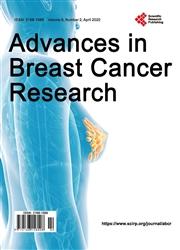Nasosinus Metastases from Breast Cancer: A Review of Two Cases
引用次数: 1
Abstract
Context: Breast cancer affects more than 2 million women a year worldwide. Improved treatments have made it possible to increase survival rates with more and more patients having time to develop secondary locations. Nasosinus metastases from this cancer are rare. Two recently treated breast cancer patients developed metastases to the sphenoidal and maxillary sinuses. These cases gave rise to an examination of the incidence of this disease, its diagnosis, the therapeutic means envisaged and the fate of these patients. Method: We report the diagnostic and therapeutic data of two patients suffering from breast cancer and presenting metastases at the nasosinus level, with a focus on the interest of radiotherapy in palliative care. Results: The two patients aged 56 and 60 presented in the course of their breast cancer secondary localizations in the sphenoidal and maxillary sinus confirmed by endoscopy and histology. All the cases presented massive lesions associated with other secondary bone locations in particular. After local radiotherapy and systemic chemotherapy treatment, one patient died 5 months after her diagnosis and the other was alive 16 months later. Conclusion: Nasal and sinus metastases from breast cancer are rare and have a poor prognosis as disseminated disease, they do not respond well to conventional systemic therapies even if palliative radiotherapy allows local control.乳腺癌鼻窦转移2例报告
背景:癌症每年影响全球200多万妇女。随着越来越多的患者有时间发展到次要位置,改进的治疗方法使提高生存率成为可能。这种癌症的Nasosinus转移是罕见的。两名最近接受治疗的癌症患者出现蝶窦和上颌窦转移。这些病例使我们对这种疾病的发病率、诊断、设想的治疗方法以及这些患者的命运进行了检查。方法:我们报告了两例癌症患者的诊断和治疗数据,并在鼻窦水平上表现出转移,重点关注放疗在姑息治疗中的作用。结果:两例患者年龄分别为56岁和60岁,经内窥镜和组织学证实,在癌症的过程中出现了蝶窦和上颌窦的继发性定位。所有病例都表现出与其他继发性骨位置相关的巨大病变。经过局部放疗和全身化疗,一名患者在确诊5个月后死亡,另一名患者16个月后存活。结论:癌症鼻腔和鼻窦转移是罕见的,作为弥漫性疾病预后较差,即使姑息性放疗允许局部控制,它们对传统的全身治疗也没有很好的反应。
本文章由计算机程序翻译,如有差异,请以英文原文为准。
求助全文
约1分钟内获得全文
求助全文

 求助内容:
求助内容: 应助结果提醒方式:
应助结果提醒方式:


